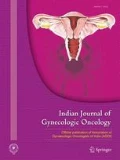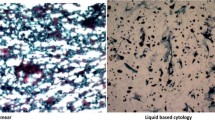Abstract
Aim
Cervical cytology is still the mainstay of cervical cancer screening programmes in developed countries, whereas this has not proved to be useful in low-resource settings.
Purpose
To audit abnormal Pap smears and their management in a tertiary care institution with an intention to improve quality of services rendered.
Methods
A list of all abnormal Pap smear (liquid-based cytology) reports between June 2012 and June 2013 was obtained from our cytopathology department. Electronic records of these patients were used to fill a proforma. The data were analysed using SPSS 19.
Results
A total of 11,984 women who attended the gynaecology clinic had Pap smears done, of which 130 were abnormal (1 %). The mean age of these women was 43. The median parity was 2 with a range of 0–6. Five women were previously treated for cancer cervix, 4 for CIN and 10 were HIV positive. ASCUS was reported in 25 (19 %), LSIL in 45 (35 %), HSIL in 41 (32 %), ASC-H in 11 (8 %), cancer in 6 (4 %) and AGC in 2 (2 %). Among those with abnormal smears, 33 women (25 %) were lost to follow up (7 HSIL, 15 LSIL and 11 ASCUS). Treatments offered included LEEP in 20 (15 %), conisation in 4 (3 %) and vaginectomy in 1. Sixteen patients eventually had hysterectomy (12 %). Immediate (see & treat) treatment was done after colposcopy in 10 women where the final biopsy was negative in 3, CIN I in 1, CIN II/III in 4 and invasive cancer in 2.
Conclusion
The follow-up of patients after Pap smear and treatment needs to be emphasized for the success of any cervical screening programme. See-and-treat methods could be carried out but have a risk of overtreatment.

Similar content being viewed by others
References
Arbyn M, Sankaranarayanan R, Muwonge R, Keita N, Dolo A, Mbalawa CG, et al. Pooled analysis of the accuracy of five cervical cancer screening tests assessed in eleven studies in Africa and India. Int J Cancer. 2008;123:153–60.
Massad LS, Einstein MH, Huh WK, Katki HA, Kinney WK, Schiffman M, et al. 2012 updated consensus guidelines for the management of abnormal cervical cancer screening tests and cancer precursors. J Low Genit Tract Dis. 2013;17(5 Suppl 1):S1–27.
Asthana S, Chauhan S, Labani S. Breast and cervical cancer risk in India: an update. Indian J Public Health. 2014;58:5–10.
Rengaswamy S, Budukh AM, Rajkumar R. Effective screening programmes for cervical cancer in low- and middle-income developing countries. Bull World Health Organ. 2001;79(10):954–62.
Arbyn M, Bergeron C, Klinkhamer P, Martin-Hirsch P, Siebers AG, Bulten J. Liquid compared with conventional cervical cytology: a systematic review and meta-analysis. Obstet Gynecol. 2008;111(1):167–77.
Lindau ST, Basu A, Leitsch SA. Health literacy as a predictor of follow-up after an abnormal Pap smear: a prospective study. J Gen Intern Med. 2006;21(8):829–34.
McKee DM, Lurio J, Marantz P, Burton W, Mulvihill M. Barriers to follow–up of abnormal Papanicolaou smears in an urban community health center. Arch Fam Med. 1999;8:129–34.
Megevand E, Wyk WV, Knight B, Bloch B. Can cervical cancer be prevented by a see, screen, and treat program? a pilot study. Am J Obstet Gynecol. 1996;174(3):923–8.
Coker AL, Bond SM, Pirisi LA. Life stressors are an important reason for women discontinuing follow-up care for cervical neoplasia. Cancer Epidemiol Biomarkers Prev. 2006;15(2):321–5.
Cho HB, Kim JH. Treatment of the patients with abnormal cervical cytology: a “See-and-Treat” versus three-step strategy. J Gynecol Oncol. 2009;20(3):164–8.
Rengaswamy S. ‘See-and-Treat’ works for cervical cancer prevention: what about controlling the high burden in India? Indian J Med Res. 2012;135:576–9.
Dainty LA, Elkas JC, Rose GS, Zahn CM. Controversial topics in abnormal cervical cytology: ‘‘See and Treat’’. Clin Obstet Gynecol. 2005;48(1):193–201.
Aue-aungkul A, Punyawatanasin S, Natprathan A, Srisomboon J, Kietpeerakool C. “See and Treat” approach is appropriate in women with high grade lesions on either cervical cytology or colposcopy. Asian Pac J Cancer Prev. 2011;12:1723–6.
Author information
Authors and Affiliations
Corresponding author
Rights and permissions
About this article
Cite this article
Thomas, V., Sudrania, I., Sebastian, A. et al. Management of Abnormal Pap Smears in a Tertiary Care Hospital. Indian J Gynecol Oncolog 13, 10 (2015). https://doi.org/10.1007/s40944-015-0012-6
Received:
Accepted:
Published:
DOI: https://doi.org/10.1007/s40944-015-0012-6



